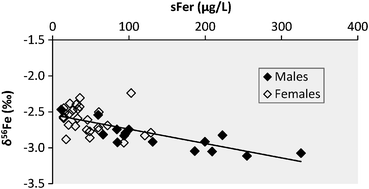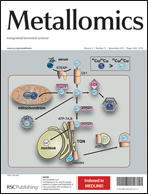As the iron status of an individual cannot be adequately assessed on the basis of the (total) Fe concentration in whole blood or serum, in medicine a number of parameters, such as the serum concentrations of ferritin, transferrin and soluble transferrin receptor and the transferrin saturation, are routinely determined instead. As previous research has shown that also the isotopic composition of Fe in blood and tissues is dependent on the metabolism, the present study assessed whether Fe isotopic composition in whole blood provides information as to an individual's iron status. Fe isotopic analysis of whole blood samples from a reference population (healthy volunteers) was carried out using multi-collector ICP-mass spectrometry (after chromatographic target element isolation) and the results obtained were investigated by statistical means as to their potential relation with the iron status parameters conventionally used in medicine. A low δ56Fe value was demonstrated to coincide with high iron status and a high δ56Fe value with low iron status, thus reflecting the response of the body to this iron status in terms of iron uptake, distribution between blood and stores and mobilization of storage iron. In a second phase, the iron isotopic composition in blood from patients treated for hemochromatosis type I and from patients with anemia of chronic disease (ACD) was determined. The results for hemochromatosis patients plotted with the values of low iron status, while those for ACD patients plotted with the values of high iron status. By taking a closer look at the aberrant iron metabolism that comes with these diseases, it can be seen that the patient samples confirm the conclusions drawn for the reference population. Patients with hemochromatosis type I have a strongly upregulated iron uptake, like healthy individuals with low iron status. The metabolism of patients suffering from ACD tries to remove iron from the circulation by downregulating the iron uptake, moving more absorbed iron to the stores and by not using any iron from these storage sites, which is in agreement with the responses of the human body to high iron status. This suggests that the conclusions made for healthy individuals are extendable to patients with aberrant iron metabolism.

You have access to this article
 Please wait while we load your content...
Something went wrong. Try again?
Please wait while we load your content...
Something went wrong. Try again?


 Please wait while we load your content...
Please wait while we load your content...